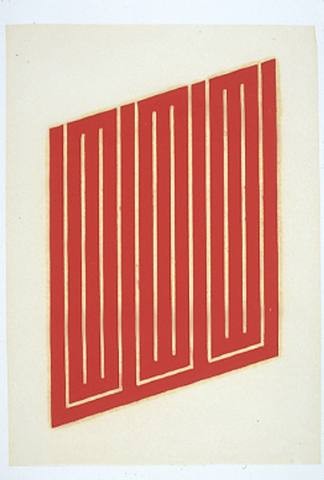Donald Judd
02 - 31 May 2008
DONALD JUDD
NEW YORK -- The Paula Cooper Gallery will present an exhibition of Donald Judd woodcuts at 521 West 21st Street, from 2 May through 31 May, 2008. The exhibition includes over 30 woodcuts on paper in cadmium red, cerulean blue or black, most dating from the early 1960s, with one print from 1955.
From the mid-1950s to 1961, as he explored the medium of the woodcut, Judd progressively moved from figurative to increasingly abstract imagery, first carving organic rounded shapes, then, working with his father Roy in 1960-1961, moving on to the painstaking craftsmanship of straight lines and angles (which require mechanical tools and a less instinctive, more planned approach). As described by Judd’s son Flavin, “These were the decisive years. He had moved to a new way of thinking: he would divide and use space instead of imposing something upon it.”
A catalogue titled “Donald Judd: Woodcuts,” with essays by Jeffrey Weiss and Flavin Judd, was published to accompany the exhibition and is available from the gallery’s bookstore.
Donald Judd was born in Excelsior Springs, Missouri, in 1928 and studied art at the Art Students League in New York in the 1950s and had his first exhibition at the Panoramas Gallery in 1957. He abandoned painting for sculpture in the early 1960s and wrote his famous manifesto-like essay “Specific Objects” in 1964. The Whitney Museum presented the first retrospective of Judd’s work in 1968. Judd moved to Marfa in 1972 while his career continued unabated: he participated in his first Venice Biennale in 1980 and in Documenta, Kassel, in 1982. The Stedelijk Van Abbemuseum organized a large traveling exhibition in 1987, and the Whitney presented a second retrospective in 1988. The Chinati Foundation, a showcase for Judd’s and other sculptors’ work, opened in Marfa in 1986. Donald Judd died in 1994 in New York.
NEW YORK -- The Paula Cooper Gallery will present an exhibition of Donald Judd woodcuts at 521 West 21st Street, from 2 May through 31 May, 2008. The exhibition includes over 30 woodcuts on paper in cadmium red, cerulean blue or black, most dating from the early 1960s, with one print from 1955.
From the mid-1950s to 1961, as he explored the medium of the woodcut, Judd progressively moved from figurative to increasingly abstract imagery, first carving organic rounded shapes, then, working with his father Roy in 1960-1961, moving on to the painstaking craftsmanship of straight lines and angles (which require mechanical tools and a less instinctive, more planned approach). As described by Judd’s son Flavin, “These were the decisive years. He had moved to a new way of thinking: he would divide and use space instead of imposing something upon it.”
A catalogue titled “Donald Judd: Woodcuts,” with essays by Jeffrey Weiss and Flavin Judd, was published to accompany the exhibition and is available from the gallery’s bookstore.
Donald Judd was born in Excelsior Springs, Missouri, in 1928 and studied art at the Art Students League in New York in the 1950s and had his first exhibition at the Panoramas Gallery in 1957. He abandoned painting for sculpture in the early 1960s and wrote his famous manifesto-like essay “Specific Objects” in 1964. The Whitney Museum presented the first retrospective of Judd’s work in 1968. Judd moved to Marfa in 1972 while his career continued unabated: he participated in his first Venice Biennale in 1980 and in Documenta, Kassel, in 1982. The Stedelijk Van Abbemuseum organized a large traveling exhibition in 1987, and the Whitney presented a second retrospective in 1988. The Chinati Foundation, a showcase for Judd’s and other sculptors’ work, opened in Marfa in 1986. Donald Judd died in 1994 in New York.

